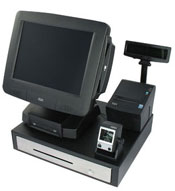|
|
|
POINT OF SALE SYSTEMS
POS is an abbreviation for point of sale (or point-of-sale, or point of service). The point of sale sometimes refers to the electronic cash register system. The point of sale systems are used in hotels, stadiums, restaurants, casinos, as well as retail environments. History of Point of Sale Systems In August of 1973 IBM announced the IBM 3650 and 3660 Store Systems In 1973 new registers that were driven by computers were introduced, such as the IBM 3653 Store System and the NCR 2150 that were, in essence, a mainframe computer packaged as a store controller that could control 128 IBM 3653/3663 Point of Sale Registers. This system was the first commercial use of client-server technology, peer to peer communications, Local Area Network (LAN) simultaneous backup, and remote initialization. Other computer-based manufacturers were Regitel, TRW, and Datachecker. 1973 also brought the introduction of the UPC barcode readers to the point of sale systems. By mid-1974, IBM 3653 Store System was installed in Pathmark Stores in New Jersey and Dillards Department Stores. Programmability allowed retailers to be more creative. In 1979 Gene Mosher's Old Canal Cafe in Syracuse, New York was using POS software written by Mosher that ran on an Apple II to take customer orders at the restaurant's front entrance and print complete preparation details in the restaurant's kitchen. In that novel context, customers would often proceed to their tables to find their food waiting for them already. This software included real time labor and food cost reports. In 1985 Mosher introduced the first touchscreen-driven, color graphic, POS interface. This software ran on the Atari ST, the world's first consumer-level color graphic computer. By the end of the 20th century Mosher's promotion of his unpatented software paradigm had resulted in its worldwide adoption by cash register manufacturers and other POS software developers as the de facto standard for point of sale software systems. In 1987, the POS systems became mostly based on PC technology with the introduction of the IBM 4683. The system consisted of a PC-based controller and thin client based POS workstations. The system required an IBM AS/400 server to be in the network. The 4683 is still used today by some retailers. However the 4683 has been phased out by some retailers to its more modern successor, the IBM 4693 and the IBM 4694. During the late 1980s and throughout the 90s stand-alone credit card devices were developed so credit card processing could be more easily and securely added. Some popular models include the VeriFone Tranz 330, Hypercom T7 Plus, or Lipman Nurit 2085. These relatively simple devices have evolved in recent years to allow multiple applications (credit card, gift card, age verification, employee time clock) to reside on one device. Some wireless POS systems for restaurants not only allow for mobile payment processing, they also allow servers to process the entire food order right at tableside. In 1996, OPOS was first released. POS hardware interface standardization Initiatives to standardize development of computerized POS systems have been made to alleviate interconnecting POS devices. Two such initiatives are OPOS and JavaPOS, both conforming to the UnifiedPOS standard, a standard led by The National Retail Foundation. OPOS, short for OLE for POS, was the first commonly-adopted standard and was initiated by Microsoft, NCR Corporation, Epson and Fujitsu-ICL. OPOS is a COM-based interface compatible with all COM-enabled programming languages for Microsoft Windows. In 1997 JavaPOS was initiated by Sun Microsystems, IBM, and NCR Corporation In 1999 JavaPOS was first released. JavaPOS is for Java and thus largely platform independent. There are several communication protocols, which POS systems use to control peripherals. Among them are EPSON Esc/POS UTC Standard UTC Enhanced AEDEX ICD 2002 Ultimate CD 5220 DSP-800 IBM dumb terminal ADM 787/788. There are also nearly as many proprietary protocols as there are companies making POS peripherals. EMAX, used by EMAX International, was a combination of AEDEX and IBM dumb terminal. Most POS peripherals, such as displays and printers, support several of these command protocols in order to work with many different brands of POS terminals and computers. |
|
| Buy Now
| Help
| Software License
| Privacy Policy
| Free Software
|
| Inventory Software Module | Why Almyta Inventory Software? | Inventory Software Lessons: | 0 | 1 | 2 | 3 | 4 | 5 | 6 | |
© almyta systems 2003 - 2025



